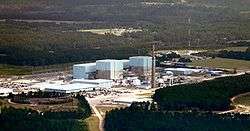Brunswick Nuclear Generating Station
| Brunswick Nuclear Plant | |
|---|---|
 Brunswick Plant | |
| Country | United States |
| Location | Smithville Township, Brunswick County, North Carolina, near Southport, North Carolina |
| Coordinates | 33°57′30″N 78°0′37″W / 33.95833°N 78.01028°WCoordinates: 33°57′30″N 78°0′37″W / 33.95833°N 78.01028°W |
| Status | Operational |
| Construction began | February 7, 1970 |
| Commission date |
Unit 1: March 18, 1977 Unit 2: November 3, 1975 |
| Construction cost | $2.490 billion (2007 USD)[1] |
| Owner(s) | Duke Energy |
| Operator(s) | Duke Energy |
| Nuclear power station | |
| Reactor type | BWR |
| Reactor supplier | General Electric |
| Cooling source | Cape Fear River |
| Power generation | |
| Units operational |
1 × 938 MW 1 × 920 MW |
| Make and model | BWR-4 (Mark 1) |
| Thermal capacity | 2 × 2923 MWth |
| Nameplate capacity | 1858 MW |
| Capacity factor |
94.43% (2017) 75.20% (lifetime) |
| Annual net output | 15,370 GWh (2017) |
The Brunswick nuclear power plant, named for Brunswick County, North Carolina, covers 1,200 acres (490 ha) at 20 feet (6.1 m) above sea level about 5 miles (8.0 km) from the Atlantic Ocean. The site is adjacent to the town of Southport, North Carolina, and to wetlands and woodlands, and was opened in 1975.
The site contains two General Electric boiling water reactors, which are cooled by water collected from the Cape Fear River and discharged into the Atlantic Ocean.
Duke Energy Progress is the majority owner (81.7%) and operator of the Brunswick nuclear plant. The North Carolina Eastern Municipal Power Agency owns the remaining 18.3%. Duke Energy Progress is currently in the process of buying The North Carolina Eastern Municipal Power Agency's 18.3% Stake at Brunswick nuclear power plant. (Duke Energy completed its merger with Progress Energy on July 2, 2012.)
The Brunswick plants' proximity to the Cape Fear River and the Atlantic Ocean allowed the designers to take in cooling water from the Cape Fear river and discharge it into the Atlantic off the coast of Oak Island. Fish, crustaceans, and other debris are removed from the cooling water via a filtration system. The water then flows through the nuclear plant and discharges into a five mile long canal which passes under the Intra-Coastal Waterway at one point.
Surrounding population
The Nuclear Regulatory Commission defines two emergency planning zones around nuclear power plants: a plume exposure pathway zone with a radius of 10 miles (16 km), concerned primarily with exposure to, and inhalation of, airborne radioactive contamination, and an ingestion pathway zone of about 50 miles (80 km), concerned primarily with ingestion of food and liquid contaminated by radioactivity.[2]
The 2010 U.S. population within 10 miles (16 km) of Brunswick was 36,413, an increase of 105.3 percent in a decade, according to an analysis of U.S. Census data for msnbc.com. The 2010 U.S. population within 50 miles (80 km) was 468,953, an increase of 39.6 percent since 2000. Cities within 50 miles include Wilmington (18 miles to city center).[3]
Seismic risk
The Nuclear Regulatory Commission's estimate of the risk each year of an earthquake intense enough to cause core damage to the reactor at Brunswick was 1 in 66,667, according to an NRC study published in August 2010.[4][5]
Hurricane Florence
The two reactors at Brunswick were shut down on Thursday, September 13, 2018, prior to tropical storm-force winds from Hurricane Florence impacting the plant. Of the nine nuclear power plants in the path of Hurricane Florence, Brunswick was the only nuclear power plant shutdown.[6][7][8]
References
- ↑ "EIA - State Nuclear Profiles". www.eia.gov. Retrieved 3 October 2017.
- ↑ "Archived copy". Archived from the original on 2006-10-02. Retrieved 2012-02-08.
- ↑ Bill Dedman, Nuclear neighbors: Population rises near US reactors, msnbc.com, April 14, 2011 http://www.msnbc.msn.com/id/42555888/ns/us_news-life/ Accessed May 1, 2011.
- ↑ Bill Dedman, What are the odds? US nuke plants ranked by quake risk, msnbc.com, March 17, 2011 http://www.msnbc.msn.com/id/42103936/ Accessed April 19, 2011.
- ↑ http://msnbcmedia.msn.com/i/msnbc/Sections/NEWS/quake%20nrc%20risk%20estimates.pdf
- ↑ Martin, Chris (September 12, 2018). "Hurricane Florence Heads for Duke Energy's Nuclear Reactors". Bloomberg. Retrieved September 14, 2018.
- ↑ "'Threat becomes reality': Hurricane Florence begins days of rain, wind". KPRC. September 13, 2018. Retrieved September 14, 2018.
- ↑ Murawski, John; Specht, Paul A. (September 13, 2018). "Duke Energy starts shutdown of NC nuclear plant as Hurricane Florence nears". News and Observer. Raleigh. Retrieved September 14, 2018.
External links
![]()